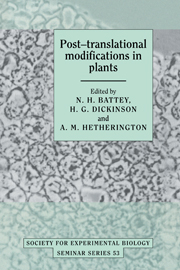Book contents
- Frontmatter
- Contents
- List of contributors
- List of abbreviations
- Preface
- Some roles of post-translational modifications in plants
- Signal transduction and protein phosphorylation in bacteria
- Roles of protein phosphorylation in animal cells
- The significance of post-translational modification of proteins by phosphorylation in the regulation of plant development and metabolism
- Post-translational modification of chloroplast proteins and the regulation of protein turnover
- Purification of a small phosphoprotein from chloroplasts and characterisation of its phosphoryl group
- Use of synthetic peptides to study G proteins and protein kinases within plant cells
- Activation of membrane-associated protein kinase by lipids, its substrates, and its function in signal transduction
- Distribution and function of Ca2+-dependent, calmodulin-independent protein kinases
- Phosphorylation of the plasma membrane proton pump
- The regulation of phosphoenolpyruvate carboxylase by reversible phosphorylation
- Protein phosphorylation and circadian rhythms
- Control of translation by phosphorylation of mRNP proteins in Fucus and Xenopus
- Regulation of plant metabolism by reversible protein (serine/threonine) phosphorylation
- Detection, biosynthesis and some functions of glycans N-linked to plant secreted proteins
- Biosynthesis, intracellular transport and processing of ricin
- Post-translational processing of concanavalin A
- The role of cell surface glycoproteins in differentiation and morphogenesis
- Ubiquitination of proteins during floral development and senescence
- Index
Biosynthesis, intracellular transport and processing of ricin
Published online by Cambridge University Press: 06 July 2010
- Frontmatter
- Contents
- List of contributors
- List of abbreviations
- Preface
- Some roles of post-translational modifications in plants
- Signal transduction and protein phosphorylation in bacteria
- Roles of protein phosphorylation in animal cells
- The significance of post-translational modification of proteins by phosphorylation in the regulation of plant development and metabolism
- Post-translational modification of chloroplast proteins and the regulation of protein turnover
- Purification of a small phosphoprotein from chloroplasts and characterisation of its phosphoryl group
- Use of synthetic peptides to study G proteins and protein kinases within plant cells
- Activation of membrane-associated protein kinase by lipids, its substrates, and its function in signal transduction
- Distribution and function of Ca2+-dependent, calmodulin-independent protein kinases
- Phosphorylation of the plasma membrane proton pump
- The regulation of phosphoenolpyruvate carboxylase by reversible phosphorylation
- Protein phosphorylation and circadian rhythms
- Control of translation by phosphorylation of mRNP proteins in Fucus and Xenopus
- Regulation of plant metabolism by reversible protein (serine/threonine) phosphorylation
- Detection, biosynthesis and some functions of glycans N-linked to plant secreted proteins
- Biosynthesis, intracellular transport and processing of ricin
- Post-translational processing of concanavalin A
- The role of cell surface glycoproteins in differentiation and morphogenesis
- Ubiquitination of proteins during floral development and senescence
- Index
Summary
Introduction
Many plant tissues produce ribosome-inactivating proteins (RIPs) which act as N-glycosidases removing a specific adenine residue from a highly conserved surface loop present in 23S, 26S and 28S ribosomal RNA (Lord, Hartley & Roberts, 1991). The adenine residue in question (adenine 4324 in rat liver 28S rRNA) (Endo et al., 1987), plays a necessary role in the binding of elongation factors, and ribosomes that have been depurinated by RIPs can no longer function in protein synthesis. Typically, a single molecule of RIP can depurinate 1500–2000 susceptible ribosomes per minute. Plant RIPs usually occur as monomeric proteins with molecular masses of around 30 kDa and are frequently but not always N-glycosylated. Although these RIPs can potently and irreversibly inactivate mammalian ribosomes they are not cytotoxic to mammalian cells since they are unable to enter such cells and reach the cytosol where their ribosome substrates are located. It has recently been found that these single-chain RIPs are also active against prokaryotic ribosomes (Hartley et al., 1991). In some instances, however, the RIP is joined via a disulphide bond to a second polypeptide which, in all cases described to date, is a galactose-binding lectin whose molecular mass is also around 30 kDa. These heterodimeric plant toxins are able to bind opportunistically to eukaryotic cells by interacting with galactose residues present on cellsurface glycoproteins and glycolipids. Such cytotoxic lectins are amongst the most potent cytotoxins in Nature.
- Type
- Chapter
- Information
- Post-translational Modifications in Plants , pp. 243 - 256Publisher: Cambridge University PressPrint publication year: 1993
- 1
- Cited by



